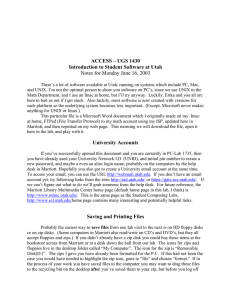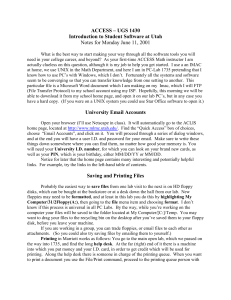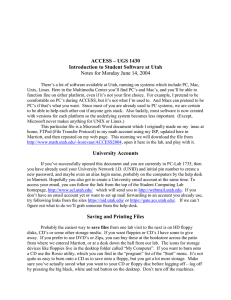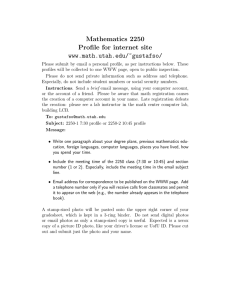ACCESS – UGS 1430 Introduction to Student Software at Utah
advertisement
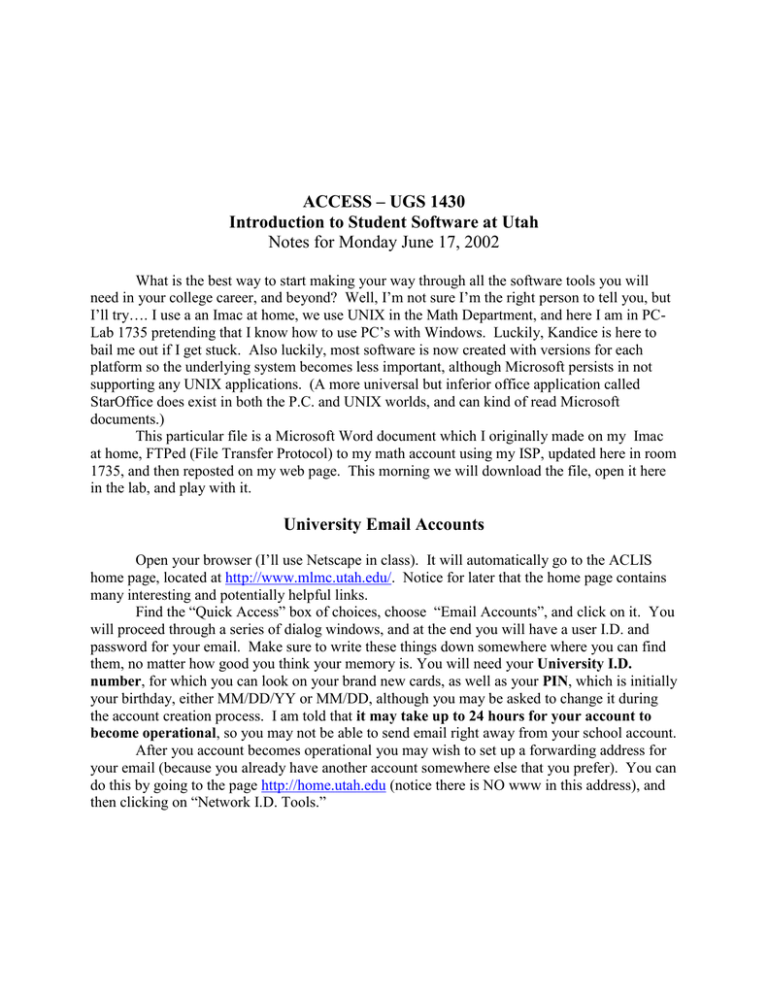
ACCESS – UGS 1430 Introduction to Student Software at Utah Notes for Monday June 17, 2002 What is the best way to start making your way through all the software tools you will need in your college career, and beyond? Well, I’m not sure I’m the right person to tell you, but I’ll try…. I use a an Imac at home, we use UNIX in the Math Department, and here I am in PCLab 1735 pretending that I know how to use PC’s with Windows. Luckily, Kandice is here to bail me out if I get stuck. Also luckily, most software is now created with versions for each platform so the underlying system becomes less important, although Microsoft persists in not supporting any UNIX applications. (A more universal but inferior office application called StarOffice does exist in both the P.C. and UNIX worlds, and can kind of read Microsoft documents.) This particular file is a Microsoft Word document which I originally made on my Imac at home, FTPed (File Transfer Protocol) to my math account using my ISP, updated here in room 1735, and then reposted on my web page. This morning we will download the file, open it here in the lab, and play with it. University Email Accounts Open your browser (I’ll use Netscape in class). It will automatically go to the ACLIS home page, located at http://www.mlmc.utah.edu/. Notice for later that the home page contains many interesting and potentially helpful links. Find the “Quick Access” box of choices, choose “Email Accounts”, and click on it. You will proceed through a series of dialog windows, and at the end you will have a user I.D. and password for your email. Make sure to write these things down somewhere where you can find them, no matter how good you think your memory is. You will need your University I.D. number, for which you can look on your brand new cards, as well as your PIN, which is initially your birthday, either MM/DD/YY or MM/DD, although you may be asked to change it during the account creation process. I am told that it may take up to 24 hours for your account to become operational, so you may not be able to send email right away from your school account. After you account becomes operational you may wish to set up a forwarding address for your email (because you already have another account somewhere else that you prefer). You can do this by going to the page http://home.utah.edu (notice there is NO www in this address), and then clicking on “Network I.D. Tools.” Saving and Printing Files Probably the easiest way to save files from one lab visit to the next is on HD floppy disks or on zip disks. If you didn’t already have a zip disk you could buy these items at the bookstore across from Marriott or at a desk down the hall from our lab. The icons for zips and floppies live in the desktop folder called “My Computer”. The icon for the zip is “Removable Disk(D:)”. The zips I gave you have already been formatted for the P.C. If this had not been the case you would have needed to highlight the zip icon, gone to “file” and chosen “format.” If in the process of your work you have saved files to the computer you may want to drag these files to the recycling bin on the desktop after you’ve saved them to your zip, but before you shut down your machine. If you are working in a group, you can trade zips, or email files to each other as attachments. Printing in Marriott works as follows: You go to the main open lab, which we passed on the way into 1735, and find the long help desk. At the far (right) end of it there is a machine into which you put money and your I.D. card, in order to get credit. This credit can be used for printing, among other things. Along the help desk there is someone in charge of the printing queue. When you want to print a document you use the File/Print command, proceed to the printing queue person with your I.D. card, tell this person how many pages to charge you for, and the I.D. number of your computer, and then go to the printers near the room entrance in order to pick up your work. Whenever you are stuck with a computer problem in Marriott, one of the friendly help desk people will try to help you. Word Processing In the old days a word processor did mostly the same things as a typewriter. (Have you whippersnappers even ever seen a working typewriter? You probably haven’t seen a slide rule either!) The symbols for controlling margins reflect this history. But notice at your upper menu bar(s) you now have zillions of other options. If you’re not familiar with them it wouldn’t be a bad idea to take some time at some point and just experiment. Actually, if you are curious about some of the options now, there will probably be a classmate who can tell you/us about it. Nowadays you can also insert all sorts of objects into your final document, including photographs, figures, equations, spreadsheets, etc. Usually you place and size these objects pretty freely. We’ll illustrate some of these ideas in Microsoft Word, but WordPerfect must have equivalent commands. Pictures You can find pictures on the Internet, save them using your browser, and then paste them into your document. Here’s a photo from the Math Department Home Page, located at http://www.math.utah.edu/. (Notice Microsoft let me enter the hyperlink, using the Insert menu choice.) I found the address for the photo by looking at the page source, saved the photo to my computer, and then pasted it into this file. (Maybe I could have been more clever?) . I got the photo credit when I clicked on the photo with one of my mouse buttons. Photo Credit Thunder Mountain January 2000 Courtesy of Steven Lewis Gardiner By the way, Steven Gardiner is the husband of Angie Gardiner, http://www.math.utah.edu/~gardiner, who is a former ACCESS student as well as being the Math Department’s Director of Undergraduate Studies. You’ll probably meet her some time during one of the Math weeks. Equations and Tables Let’s try to make this equation. If you’re using Microsoft Word go to Insert/Object and then find the equation editor, called Microsoft Equation 3.0 here at school. It will give you various template choices, and you can make equations like the one I made below. Probably this is something you want to play with when no one is watching, but give it a try now. I also constructed a table illustrating the mod 7 multiplication, using the Table menu item. n 1 2 6 n 1 X 0 1 2 3 4 5 6 0 0 0 0 0 0 0 0 1 0 1 2 3 4 5 6 2 0 2 4 6 1 3 5 3 0 3 6 2 5 1 4 4 0 4 1 5 2 6 3 5 0 5 3 1 6 4 2 6 0 6 5 4 3 2 1 2 Mathematics In our sophomore level courses, Math 2250, 2270-2280, we currently use the Mathematics package called MAPLE. It hasn’t been installed in the Course Software folder in this PC Lab because I asked too late, but it does not live on the Macs in the main Marriott Lab, and it will be installed here for your second math week Luckily for you we have a wonderful new Math center in LCB (LeRoy Cowles Building), including a nice (UNIX) lab, where you will get to learn about MAPLE tomorrow. Should you wish to, you will be able paste output from Maple documents into Microsoft documents, as I have done below. Here’s some sample output pasted into our Word document. If I had more time I would have formatted things more nicely….
